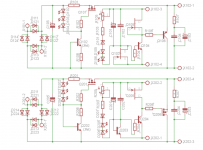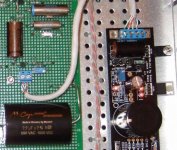I am not sure exactly what your both talking about-
Are you talking about using a large cap at the end of the reg itself, or a large cap on the device it's supplying power to?
Are you talking about using a large cap at the end of the reg itself, or a large cap on the device it's supplying power to?
I ask this particularly for my tripath amplifier 2024, as it got 2x470uf at the board.
Is there different if it is a DAC or digital transport (HiFace)?
Is there different if it is a DAC or digital transport (HiFace)?
From what I know, the shunt could get unstable and caps slows the shunt(&speed music) down. There is not really a difference, I was just wondering. Just try without the caps, should be no problem.
If you decide to keep the 2 x 470u on the board you might want to use 100r between the shunt and the board.
I did that on my pedja buffer and it worked wonders.
I did that on my pedja buffer and it worked wonders.
Update on SSLV1.1 for use with BA-2 and BA-3 front ends.
I have now changed the wiring on the reg output for each of the mono-block’s BA-2 front ends. It was interesting to listen to the difference between the regulator output with twisted pairs (a length of about 10-12cm) on the one hand and using straight wires to the front end on the other.
The general impression of the twisted pairs is that it creates a brighter (not hard) more transparent sound with much improved low level detail. I listened to a version of Spiegel im Spiegel on the radio and the reg with the twisted wires allowed much more detail from the softly repeated piano notes to be heard whereas the reg with the straight wires created a much darker background lacking in detail and a more muffled impression overall. The twisted wire version improved bass detail and leading edges generally and allowed instruments to take shape on the soundstage. This twisted pair performance is a great improvement over the previous version of taking the power from the main split rail supply using a C-R-C design whereas the straight wire version of the reg is inferior to this supply.
There is little doubt in my mind that unless one can use the twisted pair arrangement for the supply output it is not worth the trouble of building the regulator at all—it really does make that much difference.
This raises an issue with the BA-3 design, which has a positive and negative voltage input on either side of the circuit board and therefore prevents an easy application of the required twisted pair outputs from the regulator. I think this should be borne in mind if contemplating the regulator for the BA-3.
I can also conclude that there seems to be little if any alteration in the overall sound characteristics of the BA-2 design before and after the regulator is installed, i.e., there is no need to worry about the SSLV1.1 electronics adversely affecting the sound of the BA-2.
Also of note with respect to the grounding of the twisted pair voltage output. The twisted pairs (+ve and 0ve) from each output were joined near the BA-2 board to provide +ve, ground and –ve. All other ground wires were removed from the regulator (see previous post on this) with only one ground wire connecting the BA-2 board to the star ground of the main power supply.
Conclusion—the SSLV1.1 regulator makes a substantial improvement to the sound quality of the BA-2 front end provided its design is correctly implemented.
I have now changed the wiring on the reg output for each of the mono-block’s BA-2 front ends. It was interesting to listen to the difference between the regulator output with twisted pairs (a length of about 10-12cm) on the one hand and using straight wires to the front end on the other.
The general impression of the twisted pairs is that it creates a brighter (not hard) more transparent sound with much improved low level detail. I listened to a version of Spiegel im Spiegel on the radio and the reg with the twisted wires allowed much more detail from the softly repeated piano notes to be heard whereas the reg with the straight wires created a much darker background lacking in detail and a more muffled impression overall. The twisted wire version improved bass detail and leading edges generally and allowed instruments to take shape on the soundstage. This twisted pair performance is a great improvement over the previous version of taking the power from the main split rail supply using a C-R-C design whereas the straight wire version of the reg is inferior to this supply.
There is little doubt in my mind that unless one can use the twisted pair arrangement for the supply output it is not worth the trouble of building the regulator at all—it really does make that much difference.
This raises an issue with the BA-3 design, which has a positive and negative voltage input on either side of the circuit board and therefore prevents an easy application of the required twisted pair outputs from the regulator. I think this should be borne in mind if contemplating the regulator for the BA-3.
I can also conclude that there seems to be little if any alteration in the overall sound characteristics of the BA-2 design before and after the regulator is installed, i.e., there is no need to worry about the SSLV1.1 electronics adversely affecting the sound of the BA-2.
Also of note with respect to the grounding of the twisted pair voltage output. The twisted pairs (+ve and 0ve) from each output were joined near the BA-2 board to provide +ve, ground and –ve. All other ground wires were removed from the regulator (see previous post on this) with only one ground wire connecting the BA-2 board to the star ground of the main power supply.
Conclusion—the SSLV1.1 regulator makes a substantial improvement to the sound quality of the BA-2 front end provided its design is correctly implemented.
The guide specifies twisting, so all well done. Sensitivity to this has to do with the client audio boards layout to an extent too. Thanks for the detailed feedback on BA amps and regs.
An Nch jFET has the Drain to +ve and the Source to -ve.
A Pch jFET has the Drain to -ve and the Source to +ve.
See Q105 & Q205 as examples.
The gate is usually connected towards the Source voltage. Vgs is usually quite low, zero millivolts to 2Vgs
A Pch jFET has the Drain to -ve and the Source to +ve.
See Q105 & Q205 as examples.
The gate is usually connected towards the Source voltage. Vgs is usually quite low, zero millivolts to 2Vgs
Last edited:
The guide specifies twisting, so all well done. Sensitivity to this has to do with the client audio boards layout to an extent too. Thanks for the detailed feedback on BA amps and regs.
Hi,
For clarification, do you twist +/- together and sense +/- together and keep separately or twist these 2 pairs together as well?
Think of it as loop area.
The sense circuit measures the voltage between the two ends. If there is a loop inside the sense circuit then that could pick up interference.
That interference will generate an error in the sense measurement.
Similarly the force (main current flow loop) circuit contains a loop. Minimise the loop area.
I tried to get this message across what now seems like years ago, but seem not to have explained it at all well since hardly anyone has picked up on it.
The sense circuit measures the voltage between the two ends. If there is a loop inside the sense circuit then that could pick up interference.
That interference will generate an error in the sense measurement.
Similarly the force (main current flow loop) circuit contains a loop. Minimise the loop area.
I tried to get this message across what now seems like years ago, but seem not to have explained it at all well since hardly anyone has picked up on it.
Ok, loop makes sense,
Question, is it Supply+ and Sense+ twisted together or Supply+ and Supply- twisted together?
Thanks,
Question, is it Supply+ and Sense+ twisted together or Supply+ and Supply- twisted together?
Thanks,
Try to minimize the two loops.
Twist Force+ and - together. Twist Sense + and - together.
Keep both twisted pairs twisted or close together also.
Twist Force+ and - together. Twist Sense + and - together.
Keep both twisted pairs twisted or close together also.
This is the cable I'm using at present and it sounds good for the split rail supply to the BA-2 front end: Cat 5e Network Cable UTP Stranded : Cat5e Network Cables : Maplin Electronics
Since my last post I have improved the sound still further. Although using the above cable improved the level of detail and lowered background noise (better than using single wire connectors) there was a loss of bass extension and a somewhat fuzzy presentation of musical images. I reasoned that the RC circuits of the BA-2 might be responsible for interfering with the shunt regulator. I checked with Zen Mod that it was OK to remove the 1000uF caps (C205, C206) and short the R210 and R211. This has now been completed and the improvements are very significant. Clean musical images with effortless detail are now apparent and although the former isn't as precise as the BA-3 the two front ends sound very similar in this respect. Bass reach and detail have improved also and there is a real snap to the leading edges and timing so at this stage I would be happy to say I am getting the best out of the regulator/FE combination (probably!).
Chris
Since my last post I have improved the sound still further. Although using the above cable improved the level of detail and lowered background noise (better than using single wire connectors) there was a loss of bass extension and a somewhat fuzzy presentation of musical images. I reasoned that the RC circuits of the BA-2 might be responsible for interfering with the shunt regulator. I checked with Zen Mod that it was OK to remove the 1000uF caps (C205, C206) and short the R210 and R211. This has now been completed and the improvements are very significant. Clean musical images with effortless detail are now apparent and although the former isn't as precise as the BA-3 the two front ends sound very similar in this respect. Bass reach and detail have improved also and there is a real snap to the leading edges and timing so at this stage I would be happy to say I am getting the best out of the regulator/FE combination (probably!).
Chris
This reg needs no assistance after its output, additional filtering components impose their characteristics to an extent, especially the electrolytics, and are not usually better than what the reg can do alone. Zen Mod guided you correctly.
- Home
- Amplifiers
- Power Supplies
- SSLV1.1 builds & fairy tales

